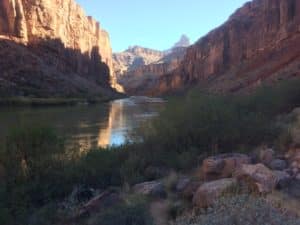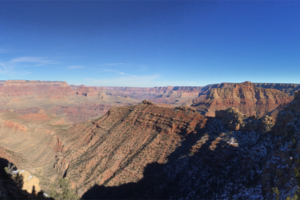What is the best hiking season in Grand Canyon?
Many of our hikers, clients, and friends are asking about our various destinations and the best time to hit them. Many of those questions revolve around Grand Canyon National Park, one of our most favorite places, and one of the most complex to explain. The reason for this is Grand Canyon’s dramatic elevation changes from rim to river, almost 7000 feet from places on the North Rim. Any given day there are 40 degree differences between the highest and lowest points. Therefore, several answers exist. The bottom line is, however, that there is a hike for every season here. In fact, depending on how adventurous you want to get, there may be some incredible adventures waiting in the off-seasons.
People always want to know the best season to visit Grand Canyon, so here is The Goat’s answer, packaged neatly as usual in a “more information than you thought you were going to get” kind of way. So ask the question, what is the best hiking season in Grand Canyon. Go ahead, ask it. What is the best hiking season in Grand Canyon. Well then, let us hike through the seasons in Grand Canyon!

What is the best time to hike ON the rim?
South Rim
The busiest season in Grand Canyon is the summer, when school is out and tourists abound. Although temperatures can get into the high 80’s and 90’s during the summer on South Rim, it is still pleasant and spectacular hiking, not to mention easy for all skill levels. South Rim amenities are open year-round, and though it receives some snow in the winter, it is generally accessible and fabulous year-round.
Winter on the South Rim can bring snow and cooler temperatures. However, most days are sunny and generally warm for winter. Temperatures on the rim can get into the 60s and 70s some days, although mornings are typically chilly. Hiking in winter on the South Rim may some days require shoe spikes or even snowshoes/crampons. The snow tends to get packed down, which can make trail conditions icy. Just be aware and don’t act a fool!
North Rim
Grand Canyon’s North Rim is absolutely prime in the summertime. Rolling aspen forests grace the approach from Jacob Lake, and oftentimes wildlife abounds. North Rim is far less crowded than the South Rim, making it attractive for people looking to lose the crowds. Like South Rim, hiking along the rim provides great vistas, but with a more contemplative feel. The waterways that have carved Grand Canyon flow mostly from the north, therefore the North Rim is more recessed. In contrast to South Rim with its abrupt cliffs dropping down to the river, North Rim’s descent is more gradual. North Rim is an exciting wilderness experience, and is our “summer adventure of choice” in Grand Canyon.
The North Rim is less accessible in the winter. Roads and amenities are generally open from May 15 – October 15. After October 15, the ranger station at the entrance is not staffed, and the gate is closed. Everything behind the station closes as well, including campgrounds and the Visitor’s Center. Accessing the park must be done on foot, which can require XC skies or snowshoes. Motorized travel is not allowed.
North Rim can receive several feet of snow in the winter. It is, after all, at almost 9,000 feet above sea level, meaning in terms of elevation you are essentially at the ski lifts of many mountains in Colorado or Utah. Winter adventures can be had, but should only be attempted with appropriate gear, acute knowledge of terrain, and winter hiking/camping experience. The North Rim is also much less visited, making it a howling wilderness in the cold months.

What is the best time to hike below the rim?
Hiking below the rim in Grand Canyon is the best way to experience its grandeur. However, summer can be hot below both rims, and people put themselves in serious danger hiking during the heat of the day in summer. Even a relatively short day hike in July or August can be unpleasantly hot. If you choose to hike below the rim in summer, be sure to start very, very early (like 4am early if you plan to reach the river) to avoid the midday heat and bring plenty of water. The best seasons to attempt day hikes below the rim are spring and fall. Never attempt to hike rim-to-river and back in one day.
Winter months bring excellent hiking conditions. Trails can be somewhat icy at times, but nothing that a decent pair of spikes and a bit of caution can’t handle. Winter is an exceptionally unique time at the canyon, with white snow contrasting against the multi-hues rocks of the gorge. South Rim hikes are generally accessible in winter, and are quite enjoyable. Day hiking from North Rim in the winter is a tougher proposition, given the fact that the roads close. You may access North Rim for hiking purposes in the winter, but you will need to hike the 18 miles in from the entrance station.
What is the best time to backpack in Grand Canyon?
As previously stated, summer can be quite warm below the rim in Grand Canyon. In fact, Inner Gorge temperatures have been known to register at over 130 degrees in the midday sun, making it at best unpleasant, and at worst deadly. Similar to day hikes, backpacking in Grand Canyon during the summer requires early start times and close attention to water intake.
Spring, autumn, and winter months bring fabulous backpacking opportunities; while it stays very cool (20-40 degrees) on the rim, perfect temperatures abound (50-60 degrees) in the Inner Gorge. In addition, permits are more easily procured as few people are applying for them. For a truly grand backpacking experience, plan your trip any time from September-April. May can be good too, but it does begin to get warm later in the month.
What is the best time to hike rim-to-rim?
Backpacking or hiking rim-to-rim is on the bucket list of many hikers all over the world. There are a several factors that make this an outstanding adventure. The most popular route is North Kaibab to South Bright Angel, with stopovers at Cottonwood Creek, Bright Angel Campground or Phantom Ranch, and Indian Gardens. The trail, traverses a part of Grand Canyon with some shade, running springs, developed campsites with running water (not available in the winter), and provides a time of year wherein the crisp waters of the Colorado are highly refreshing.
A truly outstanding route includes a pack rafting trip down the Colorado River, connecting North and South Bass Trails. The hike traverses the route carved by William Wallace Bass, and early pioneer in Grand Canyon. This backpacking trip typically takes 6 or more days, and is one of the most thrilling non-technical hiking adventures in the National Park.
It is easier logistically to do Rim-to Rim in the summer. However, permits to stay at Bright Angel Campground or Phantom Ranch can be tough to come by. Also, services at North Rim are open for a limited part of the season, and trails can even be totally inaccessible if there is snow, which occurs regularly in the cooler months.

Going Guided
Hiking and exploring Grand Canyon, or any of the National Parks, is a special experience. Although it is possible to see these places yourself, hiring a guide is a great idea. For instance, guiding services provide logistical support, and plan everything for your best possible trip. They provide a great safety net on the trail, and are trained in backcountry medicine. Above all, they provide a depth of knowledge of the region that turns a walk into a true adventure.
Blue Marble Adventure GeoTourism provides all of the support you need, and pairs that with expert geologist/guides. Our backcountry meals use fresh ingredients, and are planned by a professional chef. Furthermore, we provide top-of-the-line gear and passion for the places we explore. In conclusion, you can visit National Parks, but going with a guide can create and even more memorable experience. Don’t be shy, and call us!
The Goat’s Final Word
You wanted to know the best season to hike in Grand Canyon, and there you have it! There is a hike for every season and every hiker here. Hikes along the rim are best in the warmer months, spring-fall. Hiking on the rim can be cool in winter, bring a good jacket. Backpacking trips are best done fall-spring. Day hikes in Grand Canyon are best done in spring and fall, and in summer you should start early. Winter can bring some snow and ice, so you may way to pack a pair of spikes if you are hiking during the cold season. See you on the trail!
Read our blog!
For adventure hiking vacations in a geologic time machine, see our epic tours in Grand Canyon, Utah, and Arizona!
For geological musings read The Goat’s geology blog.
Follow us on Facebook and Instagram
Explore Further, Be Wild, See Through Time — Blue Marble Adventure GeoTourism
